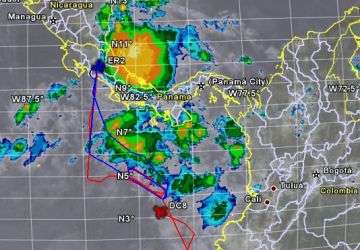Flying Into a Thunderstorm

Shakespeare's King Lear shouted to the heavens for a thunderstorm to vent its fury on him. A team of NASA scientists is hoping for precisely the same thing. They'd like a few really furious thunderstorms to come their way -- but not for Lear's dark purposes.
"We have a lot to learn about thunderstorms, and we'd like to study some at close range," says Michael Goodman, an atmospheric scientist from the Marshall Space Flight Center. "There's growing evidence that thunderstorms might play a role in climate change." But how? That is the question.
To find out, a team of researchers (Goodman included) are in Costa Rica this summer for a NASA-sponsored storm science campaign called Tropical Composition, Cloud and Climate Coupling -- TC4 for short. Like Lear himself, the scientists of TC4 will exhort the heavens to unleash their fury and, in the process, open themselves up to study.
Some thunderstorms are so violent they pump air more than 60,000 feet above Earth's surface, punching through a layer of atmosphere called the tropopause all the way into the stratosphere: diagram. TC4 pilots will fly in and around the tropopause to discover what kinds of particles are thrown up by thunderstorms and what the effect might be.
The team will also examine icy cirrus clouds that form when thunderstorms reach the tropopause. Cirrus clouds spread like a light blanket over a wide area, reflecting sunlight and cooling the Earth below. On the other hand, cirrus clouds also absorb infrared radiation coming from Earth. This "trapping" of infrared energy creates a warming effect. Particles catapulted upward by strong storms may cause changes in these icy clouds, upsetting the balance of cooling vs. warming. The net effect on Earth's energy budget? To be determined.
TC-4 researchers have many tools at their disposal: several NASA satellites, three NASA aircraft (the ER-2, WB-57, and DC-8), weather radars and a number of meteorological balloons. Each has a key role to play in piecing together the storm's "big picture," gathering data on lightning, water vapor, wind speed, infrared emissions, dust particles, carbon monoxide and more.
Most exciting are the airplanes. NASA's DC-8 seats about 35 researchers – that is, if they'll actually sit down. It seems they have a tendency to mill about and talk to one another inside the plane, swaying back and forth across the aisle.
What's it like to be among this passel of curious scientists as the plane bumps through a raging storm?
"When you are flying on the plane in the storm, you can look out of the window, and all the scientists are talking back and forth about the experiment--it's very exciting," says researcher and veteran flyer Robbie Hood of the Marshall Space Flight Center. "But there have been times when I wanted to be sitting at my desk, because I was wishing to see the satellite or radar picture at that moment."
If she flies in the DC-8 during the TC4 field campaign, her wish will come true. What makes this experiment a step up from previous weather experiments is a new tool called Real Time Mission Monitor, or RTMM. Developed at the Marshall Space Flight Center, RTMM assembles data from the whole armada of satellites and sensors and displays the big picture in living color for researchers on the plane to see. Scientists on the ground can see the display, too, and they will all be chatting with one another via instant messaging.
"I think this tool will spark people's imaginations," says Hood. "When you are looking at live data, you see things differently than you when you look at the data two weeks later at your desk. And when you have a lot of scientists focusing on something together in real time, it sparks imagination, conversation and collaboration. It will speed the way we make discoveries."
So these scientists will be brainstorming inside a storm. "Spit, fire! Spout, rain!" Let the rumbling begin.
Source: Science@NASA, by Dauna Coulter


















